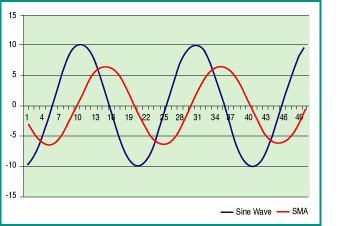First MOMA. Then VOMOMA. And Now...
Weight + Volume + Move-Adjusted Moving Average: It's
WEVOMO!
by Stephan Bisse
Moving averages: I use 'em, you use 'em, we all use 'em, but can they really tell you anything about the future direction of a time series? In this article, the third of a series, we look at minimizing the lag even more using the weighted move- and volume-adjusted moving average.
Moving averages merely give you a view of where a time series has been in the past. So how can it be used as a predictor? The only way is by adding more information into the calculation. But if you do this you have to make sure it is a leading indicator for the time series in question. In other words, changes in the additional information must be correlated to future changes in the time series.
In my February 2005 article, "Visiting MOMA," I adjusted a simple moving average (SMA) by taking each datapoint in the lookback period and weighting it according to the absolute magnitude of the move that preceded it relative to the sum of all of the absolutes in the lookback period. I christened this new moving average MOMA.
In my March 2005 article, "Adding Volume To The Move-Adjusted Moving Average," I further adjusted MOMA by the relative magnitude of the volume of each datapoint in the lookback period to create a double-adjusted moving average, which I christened VOMOMA. The idea behind MOMA is that a strong move in a given direction is a harbinger of the future direction of the market, and therefore weighting an average by the magnitude of the moves between datapoints can produce timelier signals than a standard SMA. The additional step to VOMOMA is based on the logic that large moves accompanied by heavy volume are more significant than those accompanied by light volume. Therefore, a moving average adjusted by both volume and size of move can capture these additional nuances.

FIGURE 1: LAG IN MOVING AVERAGES. Here you see a sine wave with a frequency of 20- vs. a 10-day simple moving average (SMA). Note that there is a five-day lag in the SMA.
...Continued in the April issue of Technical Analysis
of STOCKS & COMMODITIES
Excerpted from an article originally published in the April 2005
issue of Technical Analysis of STOCKS & COMMODITIES magazine.
All rights reserved. © Copyright 2005, Technical Analysis,
Inc.
Return to April 2005 Contents